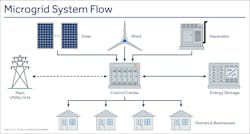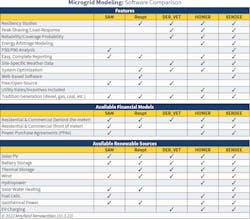The Evolution of Microgrids
The majority of the U.S. electric grid was built in the early 20th century — designed for the one-way transfer of electricity from large fossil-fuel power plants in rural areas directly to consumers in cities. With the accelerated adoption of variable renewable energy sources (VREs) and distributed energy resources (DERs), such as rooftop solar and electric vehicles, to say the energy landscape has changed over the last 10 to 15 years would be an understatement. These modern energy flows are much more complex than the grid of the early 1900s planned to handle. Although redesigning our electric infrastructure to meet this changing landscape will require significant innovation and investment, it is ultimately a necessary (and some would say an overdue) endeavor.
Given the widespread expansion of VREs, the grid is evolving to become more responsive. Integrated, advanced control systems and other digital technologies work with existing equipment to respond more quickly and accurately to electricity supply and demand changes. But the scale of these solutions has not met the scale of the challenge just yet. Microgrids have emerged as flexible, scalable solutions that can integrate and manage the many distributed VREs required to meet much of the world’s climate goals.
Considering the length of time we have worked with the existing grid technologies and concepts, it’s understandable that some discomfort exists around microgrids. This article will provide a simple overview of what a microgrid is, how it is constructed, and some typical applications for a microgrid system.
What is a microgrid?
The term “microgrid” is not always clear or well understood. Ask five people to describe a microgrid, and you will likely get five different answers. For the purpose of this article, we will use the Department of Energy’s definition:
“A group of interconnected loads and distributed energy resources within clearly defined electrical boundaries that acts as a single controllable entity with respect to the grid. A microgrid can connect and disconnect from the grid to enable it to operate in both grid-connected or island mode.”
This definition requires three features that distinguish it from a standard “macrogrid,” including:
- An easily identifiable boundary from the rest of the grid.
- Resources within the microgrid are controlled together.
- The microgrid can function whether or not it is connected to the larger grid.
Key components
A microgrid can be broken down into three key components: generation, load (demand), and storage — all of which exist within the same controlled network (see Figure).
The microgrid must have at least one generation source to meet on-site electrical demand. Historically, fast-starting, robust diesel generators have been the dominant power generation sources for most microgrids. However, with the falling cost of solar PV and energy storage, many microgrid developers are either skipping the diesel generator entirely or reducing its fuel burn by installing a solar-plus-storage system. An energy storage system (ESS), as with a fossil-fuel generator, can respond quickly to changes in demand.
Beyond generation and storage components, sophisticated control systems act as the brains of a microgrid. A typical control system includes many distributed controllers and sensors and a central supervisory control and data acquisition (SCADA) system to collect data and distribute instructions. The software behind the controls can balance the load by increasing generation or decreasing demand elsewhere on the microgrid, maximizing renewable energy usage and minimizing other electricity costs. Microgrids also contain many of the same critical components required for the standard grid, such as transformers, inverters, switchgear, and protective devices; however, they’re scaled down to the appropriate size for the system.
Real-world applications
Residential buildings, large commercial stores, and even entire university campuses utilizing microgrids can see increased resiliency and reliability. Microgrid development is a force multiplier for grid reliability, resiliency, security, and control. As more microgrids go online, the existing grid gets broken into smaller components that can be added together or isolated on-demand.
The existing grid connects homes, businesses, and other buildings to central power sources. This interconnectedness has one major downside — everyone is affected when part of the grid goes down. A microgrid generally operates while connected to the grid, but, more importantly, it can also decouple itself and operate on its own using local energy generation in times of crisis like storms, power outages, or even peak-rate periods. This ability to become an energy island is useful for many applications, including:
- Emergency backup — Microgrids can become electrically isolated from the rest of the grid in the event of an outage while continuing to produce and use electricity on site.
- Energy independence — A microgrid can connect to a local resource that is too small or unreliable for traditional grid use, allowing communities to be more energy independent, and, in some cases, more environmentally friendly.
- Extended islanding — A microgrid can be powered by generators, batteries, or renewable generation sources like photovoltaic solar modules. Depending on the fuel type and how the connected load controls are managed, a microgrid may be able to run on its own for weeks at a time or even indefinitely. The system can be designed with any duration of autonomy in mind.
Electrical codes & standards
The integration of multiple power production sources, energy storage devices, loads and potential interaction with the electric utility can make for a complex electrical system. Not surprisingly, this can make applying National Electrical Code (NEC) requirements complex as well. Multiple Code articles will apply to the installation of microgrid systems with the exact requirements being dependent on the equipment installed.
As with all electrical installations, Chapters 1 through 4 of the NEC will apply to microgrid systems. Table 1 is intended to help identify the most likely Code sections and scenarios that apply to microgrid systems — it is not necessarily all-inclusive. Multiple scenarios can impact other Code articles being employed, such as if EV charging is integrated into the microgrid or if wind generation is a generation source.
In addition to NEC requirements, the UL standards to which products are tested and listed are important aspects for microgrid design and installation. One of the most critical standards is UL9540 and the UL9540A testing method. UL9540, Standard for Energy Storage Systems and Equipment, is the listing specifically for ESSs.
The associated test method, 9540A is used to evaluate the thermal runaway characteristics of specific storage systems. Data can be provided by manufacturers per the results of the UL9540A testing, but this is not a listing itself. These data will help designers and installers understand the characteristics of specific battery systems when they enter thermal runaway and how to properly implement fire safety protocols.
Microgrid modeling
Many variables affect the overall results of the microgrid — starting with site-specific weather data and infrastructure will determine the total output potential. Then, the estimated total output (along with local utility rates and available incentives) can help calculate the economic benefits. Finally, economic feasibility — along with any other standards for the microgrid’s performance (e.g., load response, resiliency, energy arbitrage, etc.) — can be used to calculate a more comprehensive picture of the microgrid’s potential benefits.
Many modeling software programs/apps can simulate a microgrid’s function in a given location. Ranging from free online academic tools to paid downloads, they offer a variety of different features. Let’s review some commonly used tools for modeling microgrids. This comparison includes the National Renewable Energy Laboratory (NREL’s) System Advisor Model (SAM) and REopt® platforms, the Electric Power Research Institute’s Distributed Energy Value Estimation Tool (DER-VET™), HOMER’s Pro/Grid programs, and XENDEE.
Microgrids are definitely an up-and-coming solution, and some more advanced training in microgrid modeling and design could help prepare your team for the growing demand for these resilient renewable systems.
Key Software Features and Comparison Takeaways
There are plenty of options for modeling microgrids — both free and paid. Although the user interfaces and features vary greatly between the different platforms, for most businesses, it typically comes down to a combination of four deciding factors: modeling capabilities, price, rates/tariffs/incentives, and ease of use. Ultimately, all of these modeling software programs can elevate your company’s value proposition to current and future clients as well as ensure your microgrid systems are accurately planned and designed.
Modeling capabilities. Several different performance measures and reports can be used to define the feasibility of a microgrid, so you will need to make sure your software can handle the analyses your clients are most interested in. Some of the available reports in Table 2 on page 24 include system resiliency studies, energy arbitrage modeling, peak-shaving or load-response analyses, probability of exceedance analysis (P50/P90), and reliability/coverage probability reports. The reports generated by some programs are sophisticated enough to send directly to a client; others will require you to create your own customer-facing report.
Price. Price will always be a primary factor but shouldn’t be the only thing to consider. While paid licenses like HOMER or XENDEE definitely have more advanced user interfaces, others still yield the same quality of results for free. However, they may be less intuitive to use or contain fewer reporting features. Cost will also vary depending on the number of users in your organization, and a single license for your resident microgrid expert could more than pay for itself.
Utility tariffs/complex rate analysis. Presumably, the most important aspect of any microgrid modeling work will be the economic analysis, which includes both total system cost and potential savings after construction. Most modeling software has the ability to either download common utility rates/tariffs and incentives or manually enter them, but this information isn’t always readily available. Paid programs typically include this information in the software, which makes it much easier to accurately model the financial side of the microgrid (beyond just upfront system costs), especially for those with less experience researching utility rules and regulations.
Ease of use. Finally, ease of use could be the number one priority, especially if the users have limited experience or expertise with microgrids. Some programs focus more on the technical side while others emphasize the user experience. At the end of the day, your team needs to be able to use it accurately and efficiently. While all the programs in Table 2 offer user manuals and video tutorials, paid software programs often offer training sessions or one-on-one consultations to help you get the most out of the platform.
Reaping the rewards
When it comes to the benefits of microgrids, there are many things to consider, including:
Ease of connection for efficient, low-cost, clean energy. The microgrid manager (e.g., local energy management system) can balance generation from non-controllable renewable power sources (such as solar) with distributed, controllable generation (such as natural gas-fueled combustion turbines). They can also use stationary energy storage and batteries in electric vehicles to balance production and usage within the microgrid.
Improved operational efficiency and stability of the regional grid. When sited strategically within the electricity system, microgrids help reduce or manage electricity demand and alleviate grid congestion, lowering electricity prices and reducing peak power requirements. In this manner, microgrids may support system reliability, improve system efficiency, and help delay or avoid investment in new electric capacity.
Ancillary grid services like energy storage or spare capacity. A microgrid in grid-connected operation can provide frequency control support, voltage control support, congestion management, reduction of grid losses, and improvement of power quality. Usually, some kind of energy storage system is used to provide these services to the regional grid, but the microgrid can be used as either a load or a generator (if needed). In some places, end-users can actually be financially compensated for ancillary services.
Market challenges
Microgrids are proving to have multiple applications and benefits for users, ranging from individual residential, commercial/industrial, and communities. The design and installation of such systems require careful planning and consideration — all the way from concept to commissioning. Despite their obvious benefits, this technology also comes with its share of challenges, including:
Lack of geographical diversity and inertia to compensate for variability in generation. Microgrids lack geographical diversity, so relative variability (like increased demand or reduced generation from weather) will have a much larger impact on the system’s performance. Most microgrid-generating sources also lack the inertia used by large synchronous generators on the macrogrid for frequency and demand response. Energy storage in the microgrid can help alleviate the effects of variability, but this is also part of the reason for staying connected to the larger, regional grid.
Increased equipment costs and energy losses. Extra protective devices can add up to as much as 50% of the total microgrid cost, depending heavily on the local regulations and the microgrid design. Microgrids give up the economy of scale that is so advantageous to the macrogrid. Additionally, DC-AC conversion can waste more than 15% of the total energy produced, depending on the number of inverters in the design. Some of this energy loss is compensated by the lack of transmission distance required, but it should still be taken into consideration in any microgrid.
Remaining legal and regulatory questions. Microgrids face three types of legal hurdles: (1) laws that prohibit or limit specific activities; (2) laws that increase the cost of doing business; and (3) uncertainty, including the risk that a new law will be implemented to regulate microgrids and impose restrictions or costs not anticipated at the time of development or construction. Finally, a number of regulatory questions remain before the widespread adoption of microgrids is even possible, including:
- Should microgrids count as “utilities” and be subject to state/federal regulation?
- Will microgrids be subject to consumer protection laws like utilities?
- If not a utility, what are the laws for buying/selling excess electricity and other ancillary services?
- Who determines the minimum, maximum, and appropriate size for microgrids?
- Who is responsible for the operation and maintenance of a microgrid?
Although the answers to these questions are still evolving, one thing is certain. As the utility grid consumers are connected to continues to become less reliable as time goes on — whether that’s due to aging/outdated infrastructure, increased demand, or a combination of both — the future of microgrids looks bright, offering a reliable and safe way to keep the lights on.
An industry leader since 2007, Mayfield Renewables is a technical consultancy delivering a variety of services—including system design, specialized consulting and educational programs—to companies in the solar and energy storage industries. Our unmatched industry expertise uniquely positions us to forge long-term partnerships across our clients’ organizations, spanning engineering, marketing, sales and support. To connect with the Mayfield team, contact [email protected].





